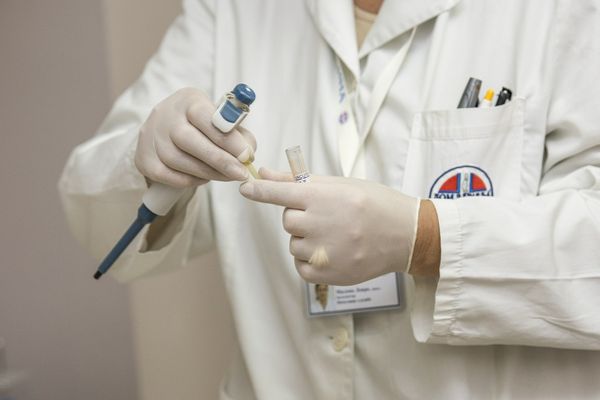11.1.3
Lymphocytes
T Lymphocytes
T Lymphocytes
T lymphocyte cells are white blood cells that are involved in the cellular immune response. The steps involved in this process are:


1) Detection of antigens
1) Detection of antigens
- The foreign antigens presented by phagocytes bind to specific receptors on the cell surface of T lymphocyte cells.
- Binding of the antigens activates the T helper cells.


2) T helper cells
2) T helper cells
- T helper (TH) cells are a specific type of T cell that activates several cells including:
- Phagocytes.
- T cytotoxic (TC) cells.
- B cells.


3) T cytotoxic cells
3) T cytotoxic cells
- TC cells are activated by TH cells.
- TC cells release toxins that bind to and kill foreign cells and abnormal cells in the body.
Interleukins
Interleukins
- T helper cells regulate the activity of other immune cells via the release of cytokines.
- Cytokines are small proteins involved in cell signalling.
- An important group of cytokines involved in regulating immune response are interleukins.
- Interleukins can stimulate or suppress the action of other cells involved in the immune response.
B Lymphocytes
B Lymphocytes
B lymphocyte cells are white blood cells that are involved in the humoral immune response. The steps involved in this process are:


1) Activation of B cells
1) Activation of B cells
- TH cells activates B cells.
- Activation of the B cells causes the B cells to divide into identical cells called plasma cells.
- The production of plasma cells is called clonal selection.


2) Detection of antigens
2) Detection of antigens
- B cells have specific proteins called antibodies on their cell surface membranes.
- Each antibody is specific to a specific antigen.
- When an antigen binds to an antibody, an antigen-antibody complex is formed.
- Binding of antigens to B cells also causes clonal selection.


3) Plasma cells
3) Plasma cells
- Clonal selection leads to the production of many plasma cells that have the specific antibodies for the antigens present in the body.
- The antibodies are called monoclonal antibodies.
- Monoclonal antibodies bind to the antigens of the pathogens.
-min,h_400,q_80,w_640.jpg)
-min,h_400,q_80,w_640.jpg)
4) Agglutination
4) Agglutination
- Agglutination 'clumps' the pathogens together.
- The pathogens are engulfed by phagocytes via phagocytosis.
- The pathogens are destroyed.


White blood cell counts
White blood cell counts
- Measuring white blood cell counts is important in medicine.
- Raised white blood cell counts can indicate:
- Recent infection. Pathogens stimulate an immune response, so an increase in white blood cell counts.
- Certain cancers. Leukemia is a type of cancer that involves the uncontrolled growth of blood and bone marrow cells.
- The type of white blood cells that have increases levels can indicate the type of leukemia.
- For example, lymphocytic leukemia typically involves elevated B cell counts.
1Cell Structure
1.1Cell Structure
1.1.1Studying Cells - Microscopes
1.1.2Introduction to Eukaryotic & Prokaryotic Cells
1.1.3Ultrastructure of Eukaryotic Cells
1.1.4Ultrastructure of Eukaryotic Cells 2
1.1.5Ultrastructure of Eukaryotic Cells 3
1.1.6Prokaryotic Cells
1.1.7Viruses
1.1.8End of Topic Test - Cell Structure
1.1.9Exam-Style Question - Microscopes
1.1.10A-A* (AO2/3) - Cell Structure
2Biological Molecules
2.1Testing for Biological Modules
2.2Carbohydrates & Lipids
2.3Proteins
3Enzymes
4Cell Membranes & Transport
4.1Biological Membranes
5The Mitotic Cell Cycle
6Nucleic Acids & Protein Synthesis
6.1Nucleic Acids
7Transport in Plants
8Transport in Mammals
8.1Circulatory System
8.2Transport of Oxygen & Carbon Dioxide
9Gas Exchange
9.1Gas Exchange System
10Infectious Diseases
10.1Infectious Diseases
10.2Antibiotics
11Immunity
12Energy & Respiration (A2 Only)
13Photosynthesis (A2 Only)
14Homeostasis (A2 Only)
14.1Homeostasis
14.2The Kidney
14.3Cell Signalling
14.4Blood Glucose Concentration
14.5Homeostasis in Plants
15Control & Coordination (A2 Only)
15.1Control & Coordination in Mammals
15.1.1Neurones
15.1.2Receptors
15.1.3Taste
15.1.4Reflexes
15.1.5Action Potentials
15.1.6Saltatory Conduction
15.1.7Synapses
15.1.8Cholinergic Synnapses
15.1.9Neuromuscular Junction
15.1.10Skeletal Muscle
15.1.11Sliding Filament Theory Contraction
15.1.12Sliding Filament Theory Contraction 2
15.1.13Menstruation
15.1.14Contraceptive Pill
15.2Control & Co-Ordination in Plants
16Inherited Change (A2 Only)
16.1Passage of Information to Offspring
16.2Genes & Phenotype
17Selection & Evolution (A2 Only)
17.2Natural & Artificial Selection
18Classification & Conservation (A2 Only)
18.1Biodiversity
18.2Classification
19Genetic Technology (A2 Only)
19.1Manipulating Genomes
19.2Genetic Technology Applied to Medicine
19.3Genetically Modified Organisms in Agriculture
Jump to other topics
1Cell Structure
1.1Cell Structure
1.1.1Studying Cells - Microscopes
1.1.2Introduction to Eukaryotic & Prokaryotic Cells
1.1.3Ultrastructure of Eukaryotic Cells
1.1.4Ultrastructure of Eukaryotic Cells 2
1.1.5Ultrastructure of Eukaryotic Cells 3
1.1.6Prokaryotic Cells
1.1.7Viruses
1.1.8End of Topic Test - Cell Structure
1.1.9Exam-Style Question - Microscopes
1.1.10A-A* (AO2/3) - Cell Structure
2Biological Molecules
2.1Testing for Biological Modules
2.2Carbohydrates & Lipids
2.3Proteins
3Enzymes
4Cell Membranes & Transport
4.1Biological Membranes
5The Mitotic Cell Cycle
6Nucleic Acids & Protein Synthesis
6.1Nucleic Acids
7Transport in Plants
8Transport in Mammals
8.1Circulatory System
8.2Transport of Oxygen & Carbon Dioxide
9Gas Exchange
9.1Gas Exchange System
10Infectious Diseases
10.1Infectious Diseases
10.2Antibiotics
11Immunity
12Energy & Respiration (A2 Only)
13Photosynthesis (A2 Only)
14Homeostasis (A2 Only)
14.1Homeostasis
14.2The Kidney
14.3Cell Signalling
14.4Blood Glucose Concentration
14.5Homeostasis in Plants
15Control & Coordination (A2 Only)
15.1Control & Coordination in Mammals
15.1.1Neurones
15.1.2Receptors
15.1.3Taste
15.1.4Reflexes
15.1.5Action Potentials
15.1.6Saltatory Conduction
15.1.7Synapses
15.1.8Cholinergic Synnapses
15.1.9Neuromuscular Junction
15.1.10Skeletal Muscle
15.1.11Sliding Filament Theory Contraction
15.1.12Sliding Filament Theory Contraction 2
15.1.13Menstruation
15.1.14Contraceptive Pill
15.2Control & Co-Ordination in Plants
16Inherited Change (A2 Only)
16.1Passage of Information to Offspring
16.2Genes & Phenotype
17Selection & Evolution (A2 Only)
17.2Natural & Artificial Selection
18Classification & Conservation (A2 Only)
18.1Biodiversity
18.2Classification
19Genetic Technology (A2 Only)
19.1Manipulating Genomes
19.2Genetic Technology Applied to Medicine
19.3Genetically Modified Organisms in Agriculture
Unlock your full potential with Seneca Premium
Unlimited access to 10,000+ open-ended exam questions
Mini-mock exams based on your study history
Unlock 800+ premium courses & e-books